Filmic Gendered Discourses in Rural Contexts: The Case of the Camino de Santiago (Spain)
Abstract
1. Introduction
2. Literature Review
2.1. Cinema
2.2. Brief Review of Gendered Issues
3. Materials and Methods
- Linguistic code: it shapes language and sexual identities as it plays an important role in the transmission of masculinity and femininity. Dinka Acevedo and Luz Gil-Salom [1] applied the methodology proposed by Theo Van Leeuwen [80] about social actors’ representation to decipher how gender social conception is constructed by media influence (Appendix A). The roles of social actors play a significant part in the work of many critical linguists [80,81,82,83,84,85]. Since it is important to reflect on their roles in the cinema, the categories proposed by T. Van Leeuwen [80] in a critical analysis of racist discourse were selected to evaluate the cinematic critical discourse analyses. This approach is considered viable as the categories enable the identification of cultural and ideological ideas that structure the cinematic discourse set in rural space.
- Visual Code: Film is a narrative medium and an art based on language whose vocabulary is the simple photographed image [86]. Image is one of the most ancient and rich means of communication, whose reading must be considered an active rather than a passive exercise. For this reason, the analysis introduces meaningful images easily decoded by the public. Each visual analysis has its own methodology depending on the aims and the interests of the project [79]. Its immediate value is an ally for the dissemination and learning of customs and habits. For this reason, visual analysis was performed by introducing a selection of moviescapes representing female pilgrims in rural contexts.
4. Results
4.1. Movie 1: Saint Jacques … La Mecque
- Backgrounding: Two out of four background female characters are influential: Clara’s mother and Ramzi’s mother. They determine much of the action. The former fakes her death to convince her children to undertake the pilgrimage and thus spend some days together; the latter paid for Ramzi’s pilgrimage (supposedly to Mecca) because she wanted him to learn to read.
- Activation: The active social actors are mainly male characters, namely the guide, Pierre, Pierre’s driver, and the notary. The active female social actor is Clara, who also works during her pilgrimage.
- Genericization: Social actors can be represented using generic references (classes). This classification occurs through individualization (spectators are informed about pilgrims’ personal lives), aggregation (three male pilgrims), and collectivization (which refers to the group).
- Nomination: This mainly refers to the nine members of the group (who also undergo a process of collectivization) and their relatives.
- Categorization: The three male characters are generally represented as priests, thus forming a category. Female categories are four nuns, three hosts, and six pilgrim officers.
- Functionalization: The male functionalized characters are the guide (throughout the film) and Pierre (who makes constant references to his managerial responsibilities). Both roles allude to a sort of sense of leadership (in the group and in the society). Clara teaches Ramzi to read.
- Identification: This process occurs through classification and relational identification. In the case of classification, the first criterion of classification is age. There is an equal distribution among the pilgrims: four men and four women, two adult men and two adult women, and two young men and two young women, although the guide is an adult man. A second identification is the religious belonging. Two boys are Muslim, three male social actors are Christians, and six women are Christian as they are nuns. Concerning class belonging, Pierre and Camille represent a rich social class. Claude is a poor alcoholic and Ramzi and Said are quite poor. Since the beginning, the filmic text is characterized by a relational identification. Pierre, Claude, and Clara are siblings. Then, there are Pierre’ wife, Claude’s wife and daughter, and Clara’s husband, son, and daughter. The background female social actors are the brothers’ mother and Ramzi’s mother, as well as Camille’s mother and the guide’s wife.
4.2. Movie 2: Al Final del Camino
- Activation: The active female social actors are Pilar and her boss, Imma. Their active roles are maintained throughout the film. The main active male social actors are Nacho and the guru of the pilgrims’ group. They are represented and usually referred to by what they do.
- Passivation: The five subject social actors are women. Two of them are not pilgrims, but they are described by means of a physical identification and as “very stupid girls”. These actions are framed within scenes with sexual context. Within the group of the pilgrims, there are three women and six men. Two of them pretend to be homosexual, but their real intention is known to the girls, as occurs with the third social actor, who is a pilgrim. Each time she appears, there is a sexual allusion. Female pilgrims are the prey of the male social actors, as proven in the scene where two of the pilgrims try to get to know two female German pilgrims.
- Specification: This is obtained through individualization, with an unequal distribution of male (Nacho, Olmo, and Arturo) and female (Pilar and Imma) individualized social actors. The process of collectivization mainly concerns the pilgrims.
- Association: This refers to pilgrims who are considered entities.
- Indetermination: This refers to anonymous pilgrims.
- Nomination: Spectators know the names of the pilgrims of the group. The other characters are Imma and Arturo.
- Categorization: In terms of identities and functions shared with others, the dominant category is that of pilgrims.
- Identification: Concerning the relational identification, except for Pilar, the two other women of the group are wives, and the plot moves around their relationship with their husbands being in crisis. Within the status of pilgrims, the dominant categorization refers to wives and husbands or girlfriends and boyfriends. Thus, all the pilgrims of the group, apart from being recognized by their names, are classified as wife/girlfriend or husband/boyfriend.
4.3. Movie 3: The Way
- Background: The background actors are relatives of Tom (mother and wife), Joost (wife and brother), and Sarah (husband).
- Activation: The male active social actors are Tom (the protagonist), the waiters, and the policemen. The female social actors are Tom’s secretary, a waitress, and a host.
- Genericization: Two policemen are represented with generic references.
- Specification: This is achieved through individualization with three men and two women who are depicted as individuals. Collectively, the two communities represented here are that of the pilgrims (apart from the protagonist), containing three women and nine men. The other community is the gypsies, formed by various women and men, but counting them was difficult (apart from the boy who steals Tom’s rucksack).
- Nomination: The four members of the group are identified by their names. Further nomination processes concern Tom’s son (Daniel), Tom’s friends, and Tom’s patient and secretary.
- Categorization: The represented social categories include hosts (a woman and a man), one waitress, and one secretary.
- Functionalization: Those who are referred to in terms of the function are Tom, Daniel, the police commander, and Jack (the Irish writer). There is no clear reference to the jobs of the female pilgrims; for instance, we do not know what Sarah does in terms of employment.
- Identification: The classification, which behind the general classification between Europeans and Americans, is mainly based on nationality. Each time pilgrims present themselves they state their origin. For instance, the group consists of three men from the USA, Ireland, and the Netherlands, and a woman from Canada. Concerning the relational identification, the most evident relation is that between Tom and his son Daniel, followed by that between Sarah’s husband and Joost’s wife.
4.4. Movie 4: Onde Eestá a Felicidade?
- Activation: The professions represented in the film are those of Theodora and Bruno. The former is a TV show presenter; she is accompanied by her aesthetician and her technical assistant. Further active female roles are the hosts and the tourist office employees (as in Saint Jacques … La Mecque). Apart from Zeca, Theodora’s producer, the male active actors work with Nando in a TV sport program. The film is a proper activation process, as Zeca (the leader of the group) travels the Camino to produce a reality show based on Theodora’s experience along the Camino.
- Passivation: The subjected social actors are mainly women, although they are not pilgrims.
- Genericization: This refers to an actor at the end of the film who pretends to be Theodora’s Galician boyfriend.
- Specification: Individualization includes the protagonists and the main characters, Theodora, Milena, Zeca, and Bruno. They can be represented as specific, identifiable individuals for their professions and relational identifications.
- Collectivization: The two main kinds of communities are friends (three women and three men) and pilgrims (fifteen female pilgrims and nineteen male pilgrims).
- Functionalization: The women represented according to their functions are Theodora and the host of the pilgrims’ hostels. Men represented according to their function are Bruno, Zeca, and the theater actor.
- Identification: The relational identification refers to the couple, Bruno and Theodora, which is present throughout the entire plot. Then, at the end, we are introduced to Bruno’s parents.
5. Discussion
- The female protagonists and main characters are active social actors. Their professions are gendered stereotypes; for instance, Clara is a teacher (Saint Jacques … La Mecque), Pilar is a journalist for a fashion magazine (Al Final del Camino), and Theodora (Onde Está a Felicidade?) is a cook.
- In the two comedies (Al Final del Camino and Onde Está a Felicidade), the female protagonists are victims of betrayal. In both cases, they decide to walk the Camino for professional reasons, and in both cases they are accompanied by a male colleague.
- Hosts of public and private hostels are played by actresses (Saint Jacques … La Mecque, The Way, Onde Está a Felicidade?). Women work in pilgrims’ offices (they sign the stamps or give the Compostelas once in Santiago). This is a characterization of female professions along the Camino.
- The diegetic analysis reveals that in three out of four films, female pilgrims’ lives have been upset by a man (boyfriend or husband).
6. Conclusions
Funding
Conflicts of Interest
Appendix A
| Exclusion | Backgrounding | Social actors are mentioned elsewhere, and we can infer who they are. | ||
| Inclusion | Activation | Social actors are represented as the active and dynamic forces in an activity. | ||
| Passivation | Represented as “undergoing” the activity, or as being “at the receiving end of it”. | Subjected social actors are treated as objects in the representation. | ||
| Beneficialized social actors form a third party that, positively or negatively, benefits from the action. | ||||
| Genericization | Social actors can be represented by generic references (classes). | |||
| Specification | Social actors are specific and identifiable individuals. | Individualization: social actors can be referred to as individuals. | ||
| Assimilation: realized by plurality, mass nouns, and nouns denoting a group of people. | ||||
| Aggregation is realized by the presence of definite or indefinite quantifiers that either function as the enumerative or head of the nominal group. | Collectivization: groups of participants are not statistics. | |||
| Association | Groups formed by social actors and/or groups of social actors (either generically or specifically referred to) who are never labeled in the text (although the actors or groups who compose the association may themselves be named and/or categorized). | |||
| Dissociation | Associations are formed and unformed (“dissociation”). | |||
| Indetermination | Occurs when social actors are represented as unspecified, “anonymous” individuals or groups; determination is when their identity is, one way or another, specified. It is typically realized by indefinite pronouns (“somebody,” “someone,” “some,” “some people”) used in nominal function. | |||
| Differentiation | Explicitly differentiates an individual social actor or group of social actors from a similar actor or group, creating the difference between the “self” and the “other,” or between “us” and “them”. | |||
| Nomination | Social actors can be represented in terms of their unique identity by being nominated. Nomination is typically realized by proper nouns, which can be formal, semiformal, or informal. | |||
| Categorization | Social actors can be represented in terms of identities and functions they share with others (categorization). | |||
| Functionalization | Social actors are referred to in terms of an activity (something they do). | |||
| Identification | Social actors are defined according to what they are. | Classification: Social actors are referred to in terms of the major categories through which a given society or institution differentiates between classes of people. | ||
| Relational identification: represents social actors in terms of their personal, kinship, or work relations to each other. | ||||
| Physical Identification is always over-determined. Physical attributes tend to have connotations, and these can be used to obliquely classify or functionalize social actors. | ||||
References
- Acevedo Caradeux, D.; Gil Salom, L. Social Representation of Gender in Award-Winner Short Films in Spain. Procedia Soc. Behav. Sci. 2013, 95, 126–135. [Google Scholar] [CrossRef][Green Version]
- Lund, N.F.; Cohen, S.; Scarles, C. The Power of Social Media Storytelling in Destination Branding. J. Destin. Mark. Manag. 2017, 8, 271–280. [Google Scholar] [CrossRef]
- Whitson, R. Spaces of Culture and Identity Production: Home, Consumptions, and the Media. In Feminist Spaces: Gender and Geography in a Global Context; Oberhauser, A.M., Fluri, J.L., Whitson, R., Molett, S., Eds.; Routdledge: London, UK; New York, NY, USA, 2018; pp. 47–75. [Google Scholar]
- Angelucci, D. L’insconcient optique comme «cinépotentialité»: Contingence et animisme du cinéma. Chimères 2016, 2, 36–47. [Google Scholar] [CrossRef]
- Ethis, E. Sociologie du Cinéma et de ses Publics; Armand Colin: Paris, France, 2005. [Google Scholar]
- Hurault-Paupe, A. The paradoxes of cinematic movement: Is the road movie a static genre? Miranda 2014, 10. [Google Scholar] [CrossRef]
- Beeton, S. Film Induced Tourism, 2nd ed.; Channel View Publications: Clevedon, UK, 2016. [Google Scholar]
- Nicosia, E. Cineturismo e Territorio: Un Percorso Attraverso i Luoghi Cinematografici; Pàtron Editore: Bologna, Italy, 2012. [Google Scholar]
- Boccella, N.; Salerno, I. Creative Economy, Cultural Industries and Local Development. Procedia Soc. Behav. Sci. 2016, 223, 291–296. [Google Scholar] [CrossRef]
- Liefooghe, C. Introduction général. L’économie créative et ses territoires: Nouvel enjeu, premiers bilans. In L’économie Créative et Ses Territoires; Liefooghe, C., Ed.; Presses Universitaires de Rennes: Rennes, France, 2015; pp. 9–24. [Google Scholar]
- Gusman, I.; Lopez, L.; Lois González, R.C.; Santos Solla, X.M. The Challenges of The First European Cultural Itinerary: The Way to St. James. An Exploratory Study. Almatourism J. Tour. Cult. Territ. Dev. 2017, 8, 1–18. Available online: https://almatourism.unibo.it/article/view/6034. (accessed on 15 June 2020).
- Lopez, L.; Santos Solla, X.M. Analysis of Territorial Development and Management Practices along the Way to St. James in Galicia. In Managing Religious Tourism; Wiltshier, P., Griffin, M., Eds.; CABI: Oxfordshire, UK, 2019; pp. 112–123. [Google Scholar]
- Lois González, R.C. The Camino de Santiago and its contemporary renewal: Pilgrims, tourists and territorial identities. Cult. Relig. 2013, 14, 8–22. [Google Scholar] [CrossRef]
- Santos Solla, X.M. Mitos y realidades del Xacobeo. Boletín AGE 1999, 28, 103–117. [Google Scholar]
- Andrade Suarez, M.J.; Leira Landeira, G.; Caramés Valo, R. El Turismo como Factor Estratégicos de desarrollo rural: El Camino de Santiago Francés. ROTUR Rev. Ocio Tur. 2010, 3, 49–82. [Google Scholar]
- Pardellas de Blas, X. O papel do turismo no desenvolvemento de es pacio rural. In O Turismo en Galicia: Potencialidades Endóxenas de Desenvolvemento Urbano e Económico; Hernández Borge, J., Díaz Fernández, J.A., Patiño Romaris, C.A., Eds.; Diputación Provincial de Pontevedra: Pontevedra, Spain, 2000; pp. 115–132. [Google Scholar]
- Lois Gonzalez, R.; Lopez, L. El Camino de Santiago: Una aproximación a su carácter polisémico desde la geografía cultural y el turismo. Doc. Anàlisi Geogràfica 2012, 58, 459–479. [Google Scholar] [CrossRef]
- Lois González, R.C. Dotaciones y infraestructuras del Camino de Santiago. Una aproximación geográfica. In Ciudades y Villas Camineras Jacobeas: III JORNADAS de Estudio y Debate Urbanos; López Trigal, L., Ed.; Universidad de León, Secretariado de Publicaciones: León, Spain, 2000; pp. 225–245. [Google Scholar]
- Santos Solla, X.M. El Camino de Santiago: Turistas y Peregrinos hacia Compostela. Cuad. Tur. 2006, 18, 135–150. [Google Scholar]
- Lois González, R.C.; Santos Solla, X. Tourists and pilgrims on their Way to Santiago. Motives, Caminos and final destinations. J. Tour. Cult. Chang. 2015, 13, 149–164. [Google Scholar] [CrossRef]
- Pilgrims’ Reception Office. Oficina del Peregrino. Santiago Pilgrim Office. Available online: www.archicompostela.org (accessed on 20 May 2020).
- Moscarelli, R.; Lopez, L.; Lois González, R.C. Who is Interested in Developing the Way of Saint James? The Pilgrimage from Faith to Tourism. Religions 2020, 11, 24. [Google Scholar] [CrossRef]
- Lopez, L.; Lois González, R.C.; Castro Fernández, B.M. Spiritual tourism on the way of Saint James the current situation. Tour. Manag. Perspect. 2017, 24, 225–234. [Google Scholar] [CrossRef]
- Mikaelsson, L. Pilgrimage as Post-Secular Therapy. Scr. Inst. Donneriani Abo. 2012, 2, 259–273. [Google Scholar] [CrossRef][Green Version]
- Escudero Gómez, L.A. La Imagen Urbana de Santiago de Compostela (España), Un Estudio De Su Representación Pública, Mediática, Promocional Y Artística. Boletín Asoc. Geógrafos Españoles 2013, 62, 265–294. [Google Scholar] [CrossRef]
- Lopez, L.; Nicosia, E.; Lois González, R.C. Sustainable Tourism: A Hidden Theory of the Cinematic Image? A Theoretical and Visual Analysis of the Way of St. James. Sustainability 2018, 10, 3649. [Google Scholar] [CrossRef]
- Lopez, L.; Santomil Mosquera, D.; Lois González, R.C. Film-Induced Tourism in The Way of Saint James. Almatour. J. Tour. Cult. Territ. Dev. 2015, 6, 18–34. [Google Scholar] [CrossRef]
- Rodríguez Campo, M.L.; Fraiz Brea, J.A. Consideraciones estratégicas para la promoción del Turismo en Galicia través del cine. Rev. Galega Econ. 2010, 19, 1–11. [Google Scholar]
- Smith, A.T. Time Warp: Cinematic Pilgrimage to Lourdes and Santiago. Int. J. Relig. Tour. Pilgr. 2017, 5, 55–62. [Google Scholar] [CrossRef]
- Henderson, K.A. Broadening an Understanding of Women, Gender and Leisure. J. Leis. Res. 1994, 26, 1–7. [Google Scholar] [CrossRef]
- Henderson, K.A. Feminist Leisure Studies: Origins, Accomplishments and Prospects; Routledge: London, UK, 2013. [Google Scholar]
- Swain, M. Gender in tourism. Ann. Tour. Res. 1995, 22, 247–266. [Google Scholar] [CrossRef]
- Esquenazi, J. L’Interprétation du film. In Approach to Film and Reception Theories: Cinéma et Théories de la Réception; Gelly, C., Roche, D., Eds.; Presses Universitaires Blaise Pascal: Clermond Ferrand, France, 2012; pp. 55–71. [Google Scholar]
- Lane, B. What is Rural Tourism. J. Sustain. Tour. 1994, 2, 7–21. [Google Scholar] [CrossRef]
- López Palomeque, F.; Vera Rebollo, J.F. Espacios y destinos turísticos. In Geografía de España; Gil Olcina, A., Gómez Mendoza, J., Eds.; Ariel: Barcelona, Spain, 2001; pp. 545–571. [Google Scholar]
- Sparrer, M. Turismo No Espazo Rural e Desenvolvemento; Xunta de Galicia: Santiago de Compostela, Spain, 2007. [Google Scholar]
- Saarinen, J. Critical Sustainability: Setting the Limits to Growth and Responsibility in Tourism. Sustainability 2014, 6. [Google Scholar] [CrossRef]
- Figuereido, C. Narrative and visual cinematic strategies in communication design. Procedia Manuf. 2015, 3, 4358–4361. [Google Scholar] [CrossRef]
- Friedmann, G.; Morin, E. Sociologie du cinéma. Rev. Int. Film. 1952, 10, 20–24. [Google Scholar]
- Metz, C. Film Language: A Semiotics of the Cinema; Taylor, M., Translator; Oxford University Press: New York, NY, USA, 1974. [Google Scholar]
- Kracauer, S. De Cagliari á Hitler: Une Histoire du Cinéma Allemand: 1919–1933; Flammarion: Paris, France, 1973. [Google Scholar]
- Morin, E. Le Cinéma ou L’homme Imaginaire: Essai D’anthropologie Sociologique; Éditions Minuit: Paris, France, 1958. [Google Scholar]
- Sorlin, P. Sociologie du Cinéma; Aubier Montaigne: Paris, France, 1977. [Google Scholar]
- Desbois, H.; Gervais-Lambony, P.; Musset, A. Géographie: La fiction «au cœur». Ann. Géographie Géographie Fict. Réalisme 2016, 709, 235–245. [Google Scholar] [CrossRef]
- Gámir Orueta, A. Del cine unipantalla al megaplex. Transformaciones recientes en la industria de la exhibición cinematográfica en España. An. Geogr. Univ. Complut. Madr. 2002, 21, 223–253. Available online: https://revistas.ucm.es/index.php/AGUC/article/view/AGUC0101110223A/31257 (accessed on 15 May 2020).
- Gámir Orueta, A.; Manuel Valdés, C. Cine y Geografía: Espacio Geográfico, Paisaje y Territorio en las Producciones Cinematográficas. Boletín 2007, 45, 157–190. Available online: https://bage.age-geografia.es/ojs/index.php/bage/article/view/643 (accessed on 10 May 2020).
- Vergara Ovando, F. El cine, una herramienta para la compresión geográfica. Rev. Geográfica Valpso 2014, 49, 80–97. [Google Scholar]
- Iwashita, C. Media representation of the UK as a destination for Japanese tourists: Popular culture and tourism. Tour. Stud. 2006, 6, 59–77. [Google Scholar] [CrossRef]
- Kim, S.S.; Agusa, J.; Lee, H.; Chon, K. Effects of Korean television dramas on the flow of Japanese tourists. Tour. Manag. 2008, 28, 1340–1353. [Google Scholar] [CrossRef]
- Riley, R.; Baker, D.; van Doren, C.S. Movie Induced Tourism. Ann. Tour. Res. 1998, 25, 919–935. [Google Scholar] [CrossRef]
- Tooke, N.; Baker, M. Seeing is believing: The effect of film on visitor numbers to screened locations. Tour. Manag. 1996, 17, 87–94. [Google Scholar] [CrossRef]
- Said, E. Orientalism; Vintage Book Editions: New York, NY, USA, 1979. [Google Scholar]
- Tuan, Y.F. Humanistic Geography. Ann. Assoc. Am. Geogr. 1977, 66, 266–276. [Google Scholar] [CrossRef]
- Eetvelde, V.V.; Antrop, M. The significance of landscape relic zones in relation to soil conditions, settlement pattern and territories in Flanders. Landsc. Urban Plan. 2005, 70, 127–141. [Google Scholar] [CrossRef]
- Lefebvre, H. The Production of Space; Blackwell: Oxford, UK, 1991. [Google Scholar]
- Rorty, R. Philosophy and the Mirror of Nature; Blackwell: Oxford, UK, 1980. [Google Scholar]
- Bauer, S. L’Himalaya à Paris. Espace d’André Velter. In Scénarios d’Espace: Littérature, Cinéma et Parcours Urbains; Nitsch, W., Dünne, J., Eds.; Presses Universitaires Blaise Pascal: Clermont Ferrand, France, 2015; pp. 197–216. [Google Scholar]
- Hernández Ramírez, J. Turismo inducido. La configuración de la imagen turística de Sevilla a través del cine comercial. In Congr. Internacional Patrimonio, Desarrollo Rural y Turismo en el Siglo XXI; Universidad de Sevilla: Osuna, Spain, 2004. [Google Scholar]
- Escher, A. The Geography of Cinema. A Cinematic World. Erdkunde 2006, 60, 307–314. [Google Scholar] [CrossRef]
- Stoller, R. Sex and Gender; Hogarth: London, UK, 1968. [Google Scholar]
- Oakley, A. Sex, Gender and Society; Temple Smith: London, UK, 1972. [Google Scholar]
- Hubier, S.; Le Vaguaresse, E. Préface. In Gender et Séries Télévisé; Hubier, S., Le Vaguaresse, E., Eds.; Épure: Reims, France, 2016; pp. 5–15. [Google Scholar]
- Domosch, M.; Seager, J. Putting Women in Place: Feminist Geographers Make Sense of the World; Guilford Press: New York, NY, USA, 2001. [Google Scholar]
- Oberhauser, A.M.; Fluri, J.L.; Whitson, R.; Molett, S. Engaging Feminist Spaces: Introduction and Overview. I. In Feminist Spaces: Gender and Geography in a Global Context; Oberhauser, A.M., Fluri, J.L., Whitson, R., Molett, S., Eds.; Routdledge: London, UK; New York, NY, USA, 2018; pp. 1–24. [Google Scholar]
- Massey, D. For Space; SAGE Publication: London, UK, 2005. [Google Scholar]
- Walby, S. Theorizing Patriarchy; Basil Blackwell: Cambridge, UK, 1990. [Google Scholar]
- Wolfenstein, M.; Leites, N. Movies: A Psychological Study; The Free Press: Glencoe, UK, 1950. [Google Scholar]
- Haskell, M. From Reverence to Rape: The Treatment of Women in the Movies; University of Chicago Press: Chicago, IL, USA, 1973. [Google Scholar]
- Rosewarne, L. The men’s gallery: Outdoor advertising and public space: Gender, fear, and feminism. Women’s Stud. Int. Forum 2005, 28, 67–78. [Google Scholar] [CrossRef]
- Mulvey, L. Visual Pleasure and Narrative Cinema. Screen 1975, 16, 6–18. [Google Scholar] [CrossRef]
- Butler, J. Gender Trouble: Feminism and the Subversion of Identity; Routdledge: London, UK; New York, NY, USA, 1990. [Google Scholar]
- Pritchard, A.; Morgan, N.J. Constructing tourism landscapes-Gender, sexuality and space. Tour. Geogr. 2000, 2, 115–139. [Google Scholar] [CrossRef]
- Vizcaíno Suárez, L.P.; Serrano Barquín, R.; Cruz Jiménez, G.; Pastor Alfonso, M.J. Theories and Methods in Research on Tourism Gender and Women in Ibero-America: A Bibliographic Analysis. Cuad. Tur. 2016, 38, 595–599. Available online: https://revistas.um.es/turismo/article/view/271531/200101 (accessed on 15 June 2020).
- Geldsetzer, S. Towards a Definition of Women Crusaders to the Near East. In Femmes et Pèlerinages: Women and Pilgrimages; Dor, J., Henneau, M., Eds.; Compostela Group of Universities: Santiago de Compostela, Spain, 2007; pp. 47–56. [Google Scholar]
- Heene, K. The Latin discourse on Women and Mobility in the Late medieval law Countries. In Femmes et Pèlerinages: Women and Pilgrimages; Dor, J., Henneau, M., Eds.; Compostela Group of Universities: Santiago de Compostela, Spain, 2007; pp. 153–190. [Google Scholar]
- Esquenazi, J.P. L’analyse de Film Avec Deleuze; CNRS Editions: Paris, France, 2017. [Google Scholar]
- Vancheri, L. Film, Forme, Théorie; Editions Le Harmattan: Paris, France, 2002. [Google Scholar]
- Ferro, M. Cinéma et Histoire; Denoel-Gonthier: Paris, France, 1977. [Google Scholar]
- Joly, M. Introduction à L’analyse de L’image; Armad Colin: Paris, France, 2015. [Google Scholar]
- Van Leeuwen, T. Discourse and Practice; Oxford University Press: Oxford, UK, 2008. [Google Scholar]
- Fairclough, N. Analysing Discourse: Textual Analysis for Social Research; Routledge: London, UK, 2003. [Google Scholar]
- Fowler, R. Language in the News; Routledge: London, UK; New York, NY, USA, 1991. [Google Scholar]
- Fowler, R.; Hodge, B.; Kress, G.; Trew, T. Language and Control; Routledge: London, UK; Kegan Paul: London, UK, 1979. [Google Scholar]
- Kress, G.; Hodge, R. Language as Ideology; Routledge: London, UK; Kegan Paul: London, UK, 1979. [Google Scholar]
- Dijk van, T. El análisis crítico del discurso. Anthropos 1999, 186, 23–36. Available online: http://www.discursos.org/oldarticles/El%20an%E1lisis%20cr%EDtico%20del%20discurso.pdf (accessed on 15 May 2020). [CrossRef]
- Richardson, R. Literature and Film; Indiana University Press: Bloomington, IN, USA, 1970. [Google Scholar]
- Kurrant, C. Biographical Motivations of Pilgrims on the Camino de Santiago. Int. J. Relig. Tour. Pilgr. 2019, 7, 11–18. Available online: https://arrow.tudublin.ie/ijrtp/vol7/iss2/3/ (accessed on 15 May 2020).
- Kim, H.; Yilmaz, S.; Ahn, S. Motivational Landscape and Evolving Identity of a Route-Based Religious Tourism Space: A Case of Camino de Santiago. Sustainability 2019, 11, 3547. [Google Scholar] [CrossRef]
- Fluri, J. The Body, Performance and Space. In Feminist Spaces: Gender and Geography in a Global Context; Oberhauser, A.M., Fluri, J.L., Whitson, R., Molett, S., Eds.; Routdledge: London, UK; New York, NY, USA, 2018; pp. 25–46. [Google Scholar]
- Mata Olmo, R. Introducción. In Atlas de los Paisajes de Castilla- La Mancha; Pons Giner, B., Ed.; Universidad de Castilla-La Mancha: Ciudad Real, Spain, 2011; pp. 10–19. [Google Scholar]
- Morinis, A. Sacred Journeys: The Anthropology of Pilgrimage; Greenwood Press: Westport, CT, USA, 1992. [Google Scholar]
- Turner, V.; Turner, E. Image and Pilgrimage in Christian Culture; Colombia University Press: New York, NY, USA, 1978. [Google Scholar]
- Xu, H. Moving toward gender and tourism geographies studies. Tour. Geogr. 2018, 20, 721–727. [Google Scholar] [CrossRef]
- Dell’Agnese, E.; Amilhat Szary, A. Borderscapes: From Border Landscapes to Border Aesthetics. Geopolitics 2015, 20, 4–13. [Google Scholar] [CrossRef]
- Bachelard, G. La Poétique de L’espace; Les Presses Universitaires de France: Paris, France, 1957. [Google Scholar]
- Paül i Carril, V.; Trillo Santamaría, J.M. Discussing the Couto Mixto (Galicia, Spain): Transcending the territorial trap through borderscapes and border poetics analyses. Geopolitics 2015, 20, 56–78. [Google Scholar] [CrossRef]
- Minca, C.; Bialasiewicz, L. Spazio e Politica: Riflessioni di Geografia Critica; CEDAM: Padova, Italy, 2004. [Google Scholar]
- Raffestin, C. Pour une Géographie du Pouvoir; Litec: Paris, France, 1980. [Google Scholar]
- Gaudin, A. L’Espace Cinématographique: Esthétique et Dramaturgie; Armand Colin: Paris, France, 2015. [Google Scholar]
- Figueroa-Domecq, C.; Pritchard, A.; Segovia-Péreza, M.; Morgan, N.; Villacé-Molinero, T. Tourism gender research: A critical accounting. Ann. Tour. Res. 2015, 52, 87–103. [Google Scholar] [CrossRef]
- Brown, L.; Osman, H. The female tourist experience in Egypt as an Islamic destination. Ann. Tour. Res. 2017, 63, 12–22. [Google Scholar] [CrossRef]
- De Lauretis, T. Alicia ya no: Feminismo, Semiótica, Cine; Cátedra: Madrid, Spain, 1992. [Google Scholar]
- Rollet, B. Femme Set Cinéma, Sois Belle e Tait-Toi; Belin: Paris, France, 2017. [Google Scholar]
- Butler, R.W. The Influence of the Media in Shaping International Tourist Patterns. Tour. Recreat. Res. 1990, 15, 46–53. [Google Scholar] [CrossRef]
- De Los Reyes Lozano, J. La traduction du sexisme dans Mad Men, entre idéologie et restrictions. In Gender et Séries Télévisé; Hubier, S., Le Vaguaresse, E., Eds.; Épure: Reims, France, 2016; pp. 183–203. [Google Scholar]
- Lois González, R.C.; Lopez, L. Liminality Wanted. Liminal landscapes and literary spaces: The Way of St. James. Tour. Geogr. Int. J. Tour. Space Place Environ. 2020, 22, 433–453. [Google Scholar] [CrossRef]
- Countryside Commission. Sustainable Rural Tourism: A Guide to Local Opportunities; Countryside Commission: Cheltenhman, UK, 1995. [Google Scholar]
- UN. Introduction and Proposed Goals and Targets on Sustainable Development for the Post 2015 Development Agenda; UN: New York, NY, USA, 2014; Available online: https://sustainabledevelopment.un.org/content/documents/4523zerodraft.pdf (accessed on 15 June 2020).
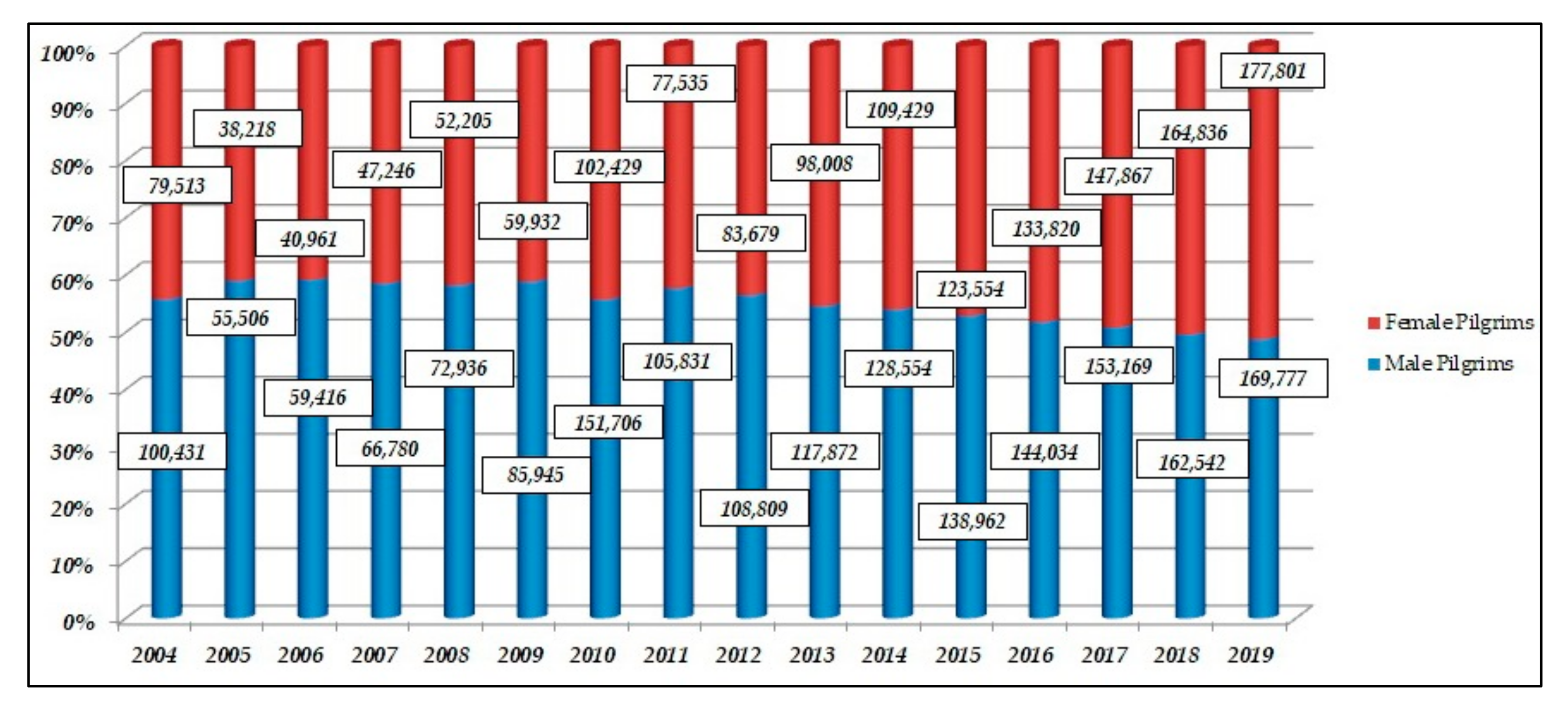


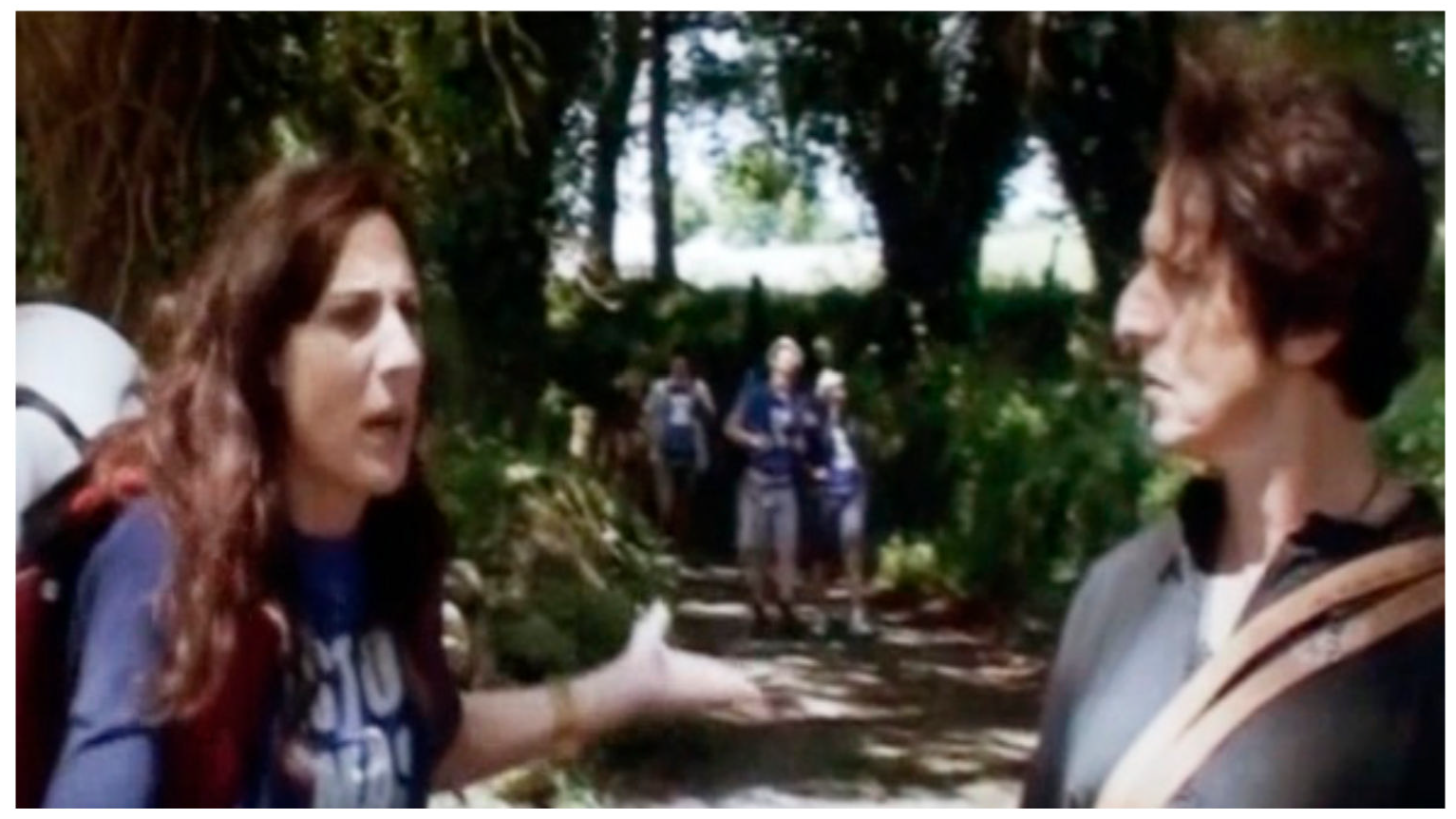

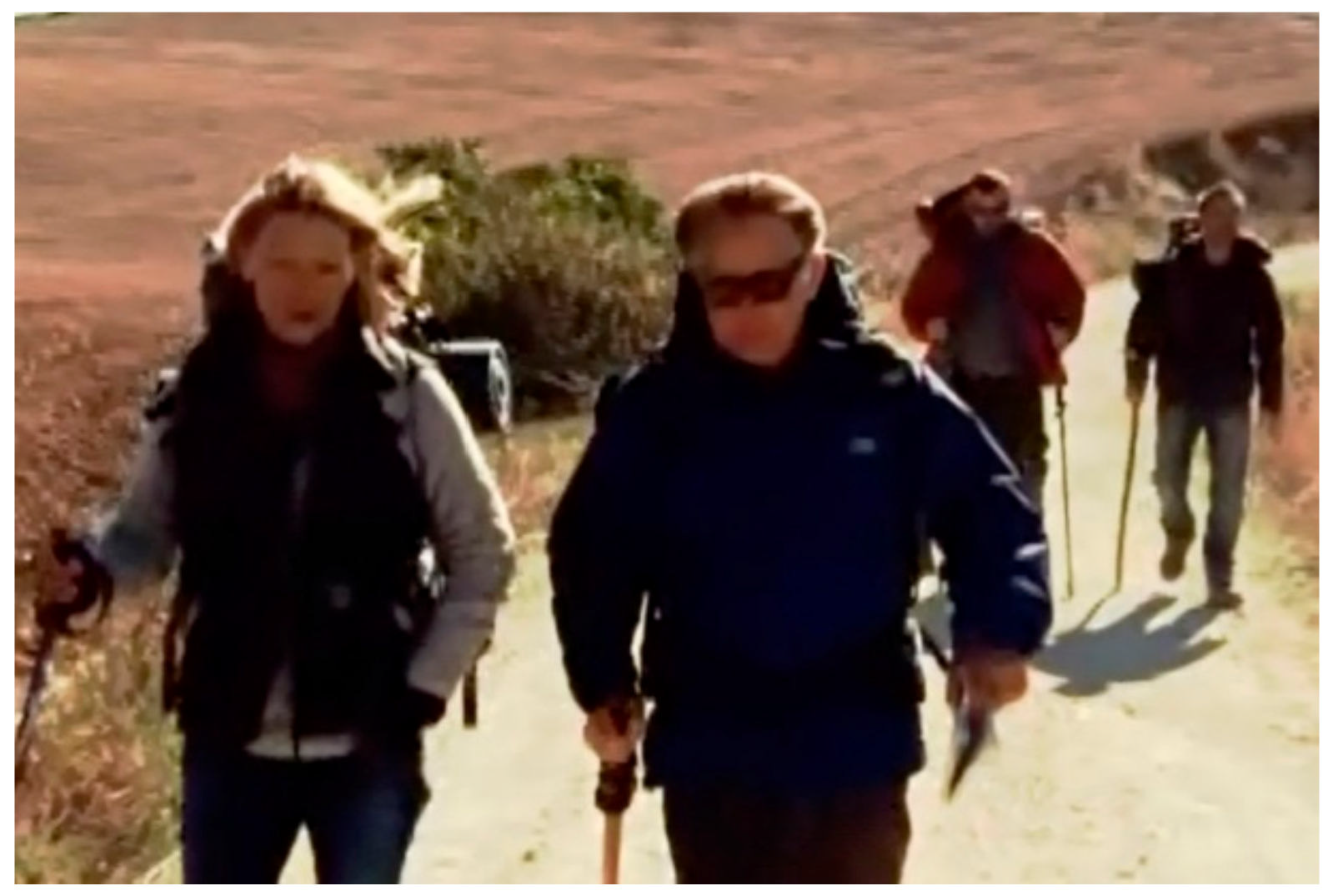
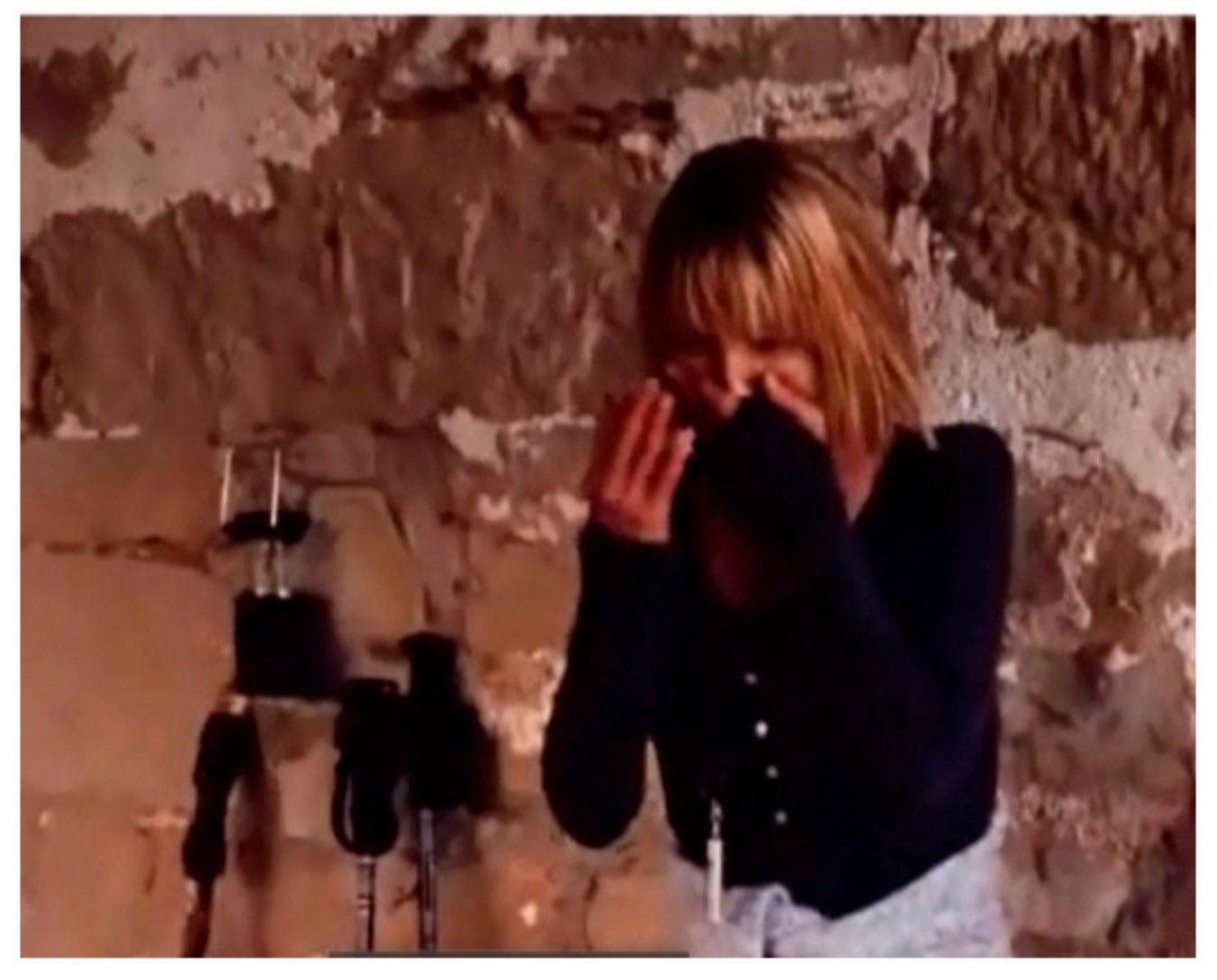
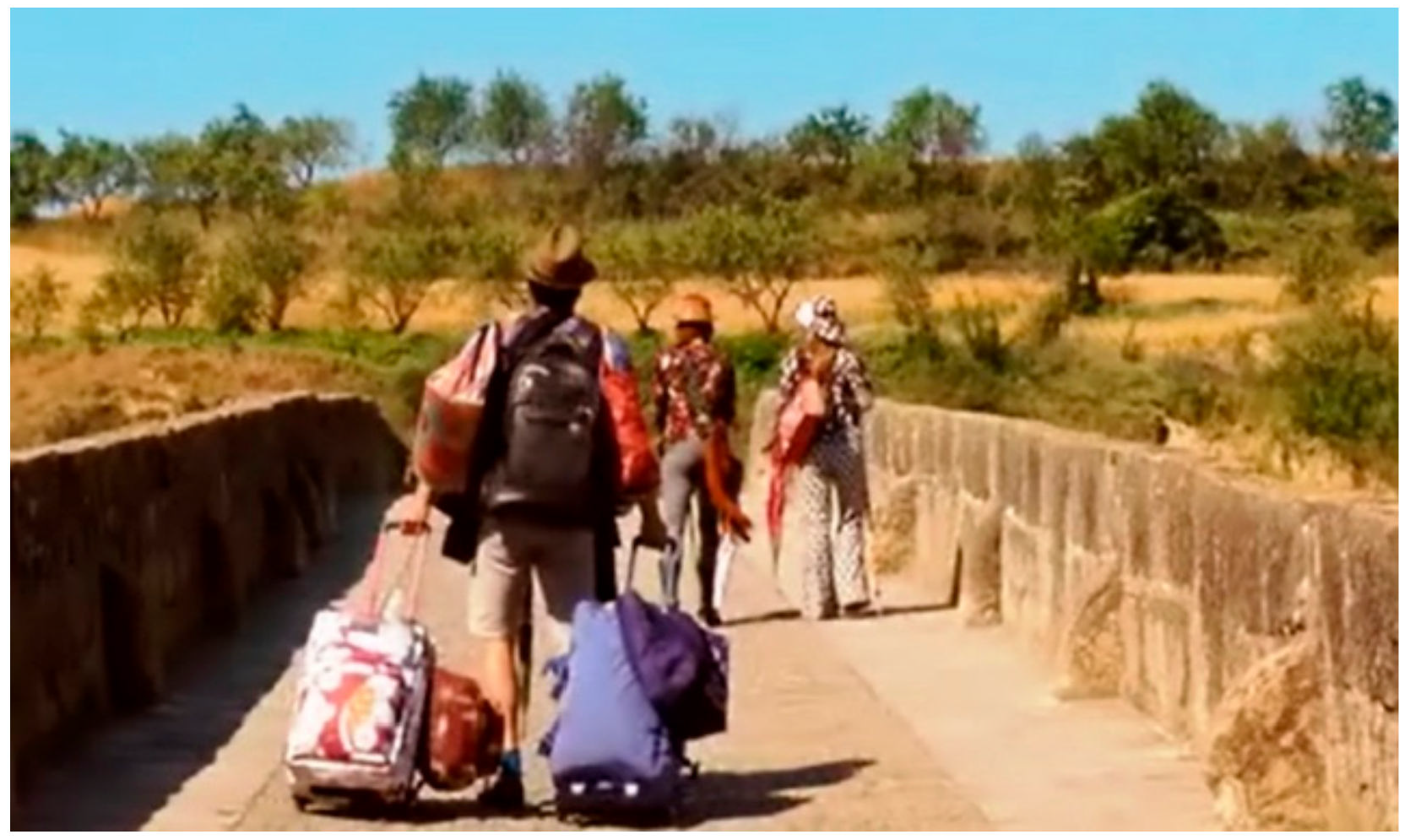
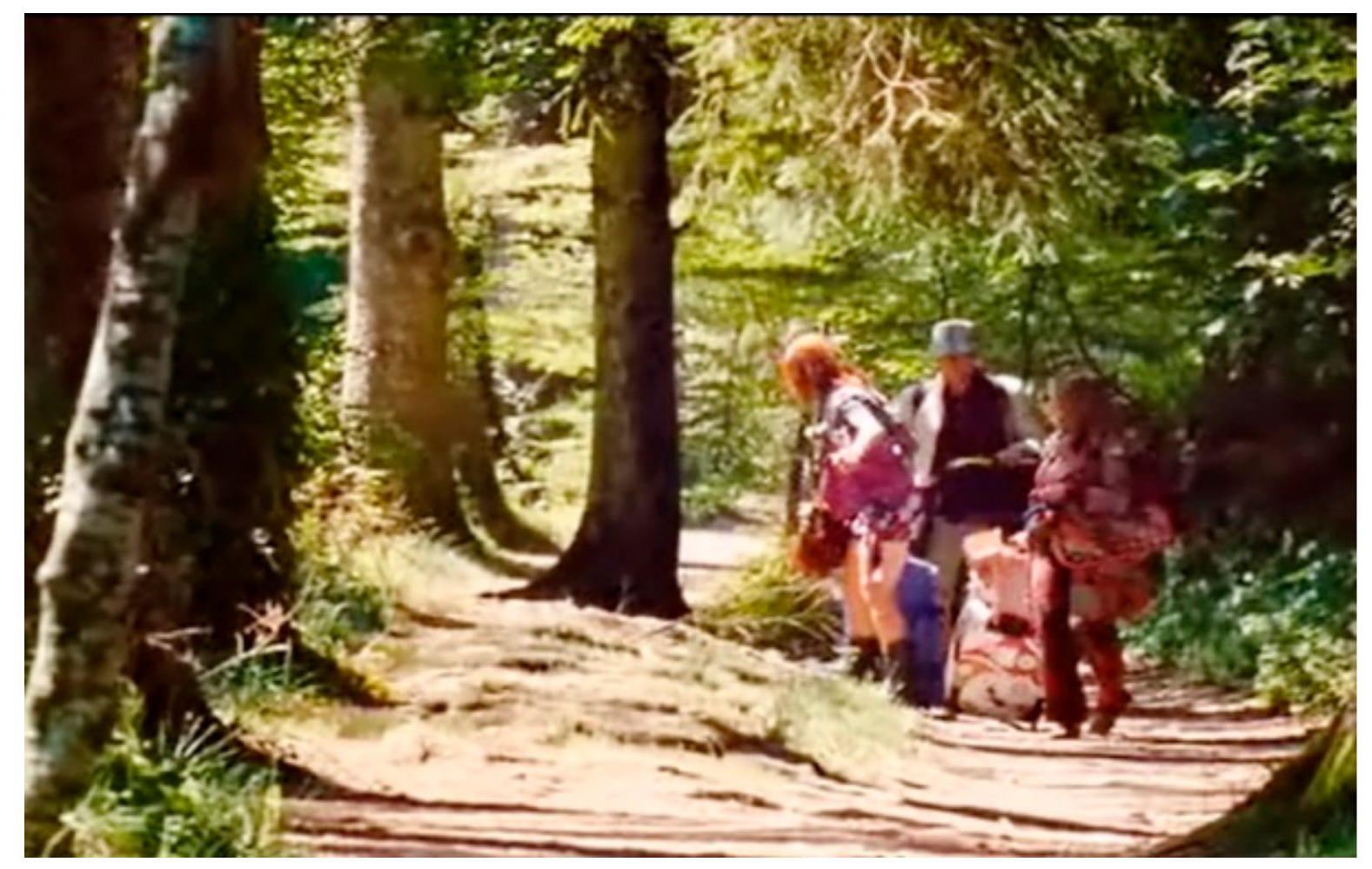
| Movie Details | Saint Jacques … La Mecque | Al Final del Camino | The Way | Onde Está a Felicidade? |
|---|---|---|---|---|
| Year | 2005 | 2009 | 2010 | 2011 |
| Country | France | Spain | USA, Spain | Brazil, Spain |
| Director | Coline Serrau | R. Santiago | Emilio Estévez | C.A. Riccelli |
| Duration | 1:45 | 1:37 | 1:22 | 1:42 |
| Reasons | Get inheritance; social experience; personal (personal thanksgiving) | Magazine report; solve couple crisis | Personal (son’s death; work crisis; search for new life); sport | Personal (search for new life); produce a reality show |
| Starting point | Puy-en Velay | Galicia | Roncesvalles | Roncesvalles |
| Male protagonist (s) | 5 | 1 | 2 | 2 |
| Female protagonist (s) | 4 | 1 | - | 1 |
| Male relevant characters | - | 6 | 2 | - |
| Other male characters | 5 | 3 | 28 | 37 |
| Female relevant characters | - | 4 | 1 | 1 |
| Other female characters | 18 | 2 | 11 | 37 |
| Genre | Tragicomedy | Comedy | Tragicomedy | Comedy |
| Saint Jacques … La Mecque | Al final del Camino | The Way | Onde Está a Felicidade? |
| Female Characters | Male Characters | |||
|---|---|---|---|---|
| Exclusion | Background | 4 | 2 | |
| Inclusion | Activation | 1 | 4 | |
| Passivation | Subjected social | 1 | - | |
| Beneficialized social actors | - | - | ||
| Genericization | 7 | 3 | ||
| Specification | Individualization | 4 | 5 | |
| Assimilation | - | - | ||
| Aggregation | - | 3 | ||
| Collectivization | 4 | 5 | ||
| Association | - | - | ||
| Dissociation | - | - | ||
| Indetermination | - | - | ||
| Differentiation | - | - | ||
| Nomination | 5 | 6 | ||
| Categorization | 13 | 4 | ||
| Functionalization | 1 | 2 | ||
| Identification | Classification | 11 | 7 | |
| Relational identification | 9 | 5 | ||
| Physical Identification | - | - | ||
| Female Characters | Male Characters | |||
|---|---|---|---|---|
| Exclusion | Background | 1 | - | |
| Inclusion | Activation | 2 | 5 | |
| Passivation | Subjected social | 5 | 1 | |
| Beneficialized social actors | - | - | ||
| Genericization | - | - | ||
| Specification | Individualization | 2 | 3 | |
| Assimilation | - | - | ||
| Aggregation | - | - | ||
| Collectivization | 3 | 4 | ||
| Association | 3 | 6 | ||
| Dissociation | - | - | ||
| Indetermination | 3 | 1 | ||
| Differentiation | - | - | ||
| Nomination | 4 | 6 | ||
| Categorization | 6 | 5 | ||
| Functionalization | 2 | 3 | ||
| Identification | Classification | - | 2 | |
| Relational identification | 4 | 3 | ||
| Physical Identification | 2 | - |
| Female Characters | Male Characters | |||
|---|---|---|---|---|
| Exclusion | Background | 3 | 2 | |
| Inclusion | Activation | 3 | 5 | |
| Passivation | Subjected social | - | - | |
| Beneficialized social actors | - | - | ||
| Genericization | - | 2 | ||
| Specification | Individualization | 2 | 3 | |
| Assimilation | - | - | ||
| Aggregation | - | - | ||
| Collectivization | 3 gypsies | 9 gypsies | ||
| Association | - | 3 | ||
| Dissociation | - | - | ||
| Indetermination | - | - | ||
| Differentiation | - | |||
| Nomination | 3 | 4 | ||
| Categorization | 3 | 1 | ||
| Functionalization | - | 3 | ||
| Identification | Classification | 2 | 5 | |
| Relational identification | 1 | 3 | ||
| Physical Identification | - | - |
| Female Characters | Male Characters | |||
|---|---|---|---|---|
| Exclusion | Background | - | 2 | |
| Inclusion | Activation | 7 | 5 | |
| Passivation | Subjected social | 6 | - | |
| Beneficialized social actors | - | - | ||
| Genericization | - | 2 | ||
| Specification | Individualization | 2 | 3 | |
| Assimilation | - | - | ||
| Aggregation | - | - | ||
| Collectivization | 3 friends 15 pilgrims | 9 gypsies | ||
| Association | - | 3 | ||
| Dissociation | - | - | ||
| Indetermination | - | - | ||
| Differentiation | - | |||
| Nomination | 4 | 4 | ||
| Categorization | 2 | 1 | ||
| Functionalization | 3 | 3 | ||
| Identification | Classification | - | 5 | |
| Relational identification | 3 | 3 | ||
| Physical Identification | - | - |
© 2020 by the author. Licensee MDPI, Basel, Switzerland. This article is an open access article distributed under the terms and conditions of the Creative Commons Attribution (CC BY) license (http://creativecommons.org/licenses/by/4.0/).
Share and Cite
Lopez, L. Filmic Gendered Discourses in Rural Contexts: The Case of the Camino de Santiago (Spain). Sustainability 2020, 12, 5080. https://doi.org/10.3390/su12125080
Lopez L. Filmic Gendered Discourses in Rural Contexts: The Case of the Camino de Santiago (Spain). Sustainability. 2020; 12(12):5080. https://doi.org/10.3390/su12125080
Chicago/Turabian StyleLopez, Lucrezia. 2020. "Filmic Gendered Discourses in Rural Contexts: The Case of the Camino de Santiago (Spain)" Sustainability 12, no. 12: 5080. https://doi.org/10.3390/su12125080
APA StyleLopez, L. (2020). Filmic Gendered Discourses in Rural Contexts: The Case of the Camino de Santiago (Spain). Sustainability, 12(12), 5080. https://doi.org/10.3390/su12125080





